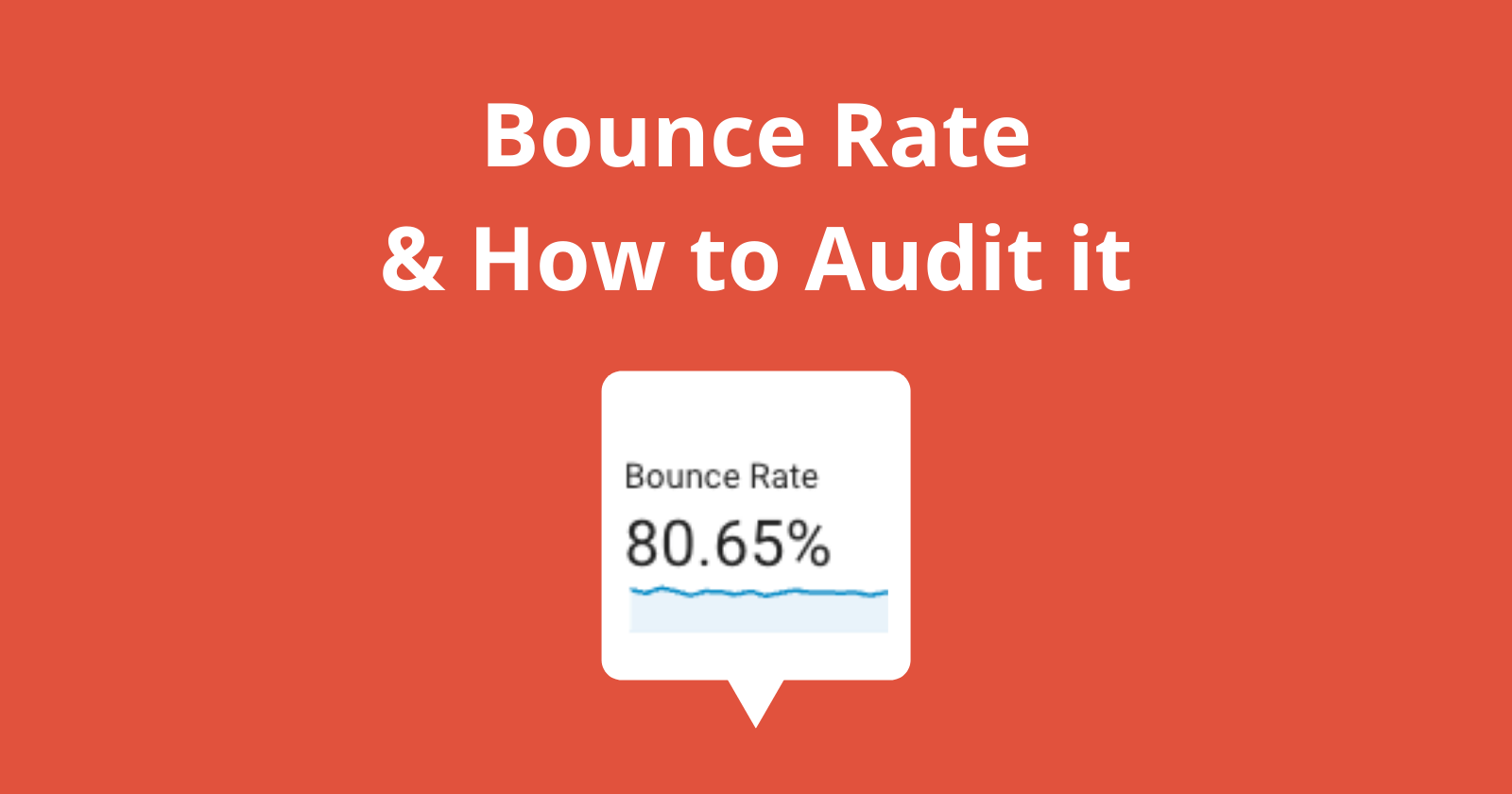It’s impossible to identify how effectively a website or landing page addresses a searcher’s intent without a means to measure the user’s attention – or engagement.
I regularly see bounce rate used as a key performance indicator (KPI) for the purpose of measuring user engagement.
But is the traditional understanding of bounce rate accurate and valid considering how users use the web today?
No, bounce rate is not a Google ranking factor.
In this article, you will learn what bounce rate means, how bounce rate is calculated, what a good bounce rate is and how to audit it correctly.
It’s a great opportunity to become comfortable using Google Analytics to ask better questions, as well.
What Is Bounce Rate?
In Google Analytics, bounce rate represents the number of sessions that triggered a single request to the Analytics server divided by the total number of sessions.
This metric can be applied to a website as a whole or a specific page.
Advertisement
Continue Reading Below
There are two pieces of terminology we need to define in order to understand what bounce rate is.
First, what is a session?
Sessions are a collection of user interactions (hits) that took place within a chosen time frame.
Think of sessions as visits. You may have had this customer in your store before but this is how many times they came in during a chosen time frame.
It’s important to note that a session resets after 30 minutes of inactivity.
And, secondly what sends a request to the Analytics server?
A request to the Google Analytics server (hits) could be viewing a second page (page_view) or triggering an event.
More on events in a minute – keep reading.
How Is Bounce Rate Calculated?
Bounce rate is calculated by single-page sessions (no subsequent hits) divided by total sessions.
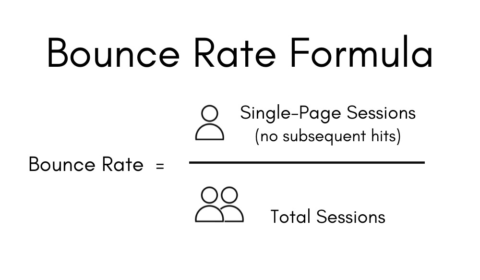 Kayle Larkin, November 2021
Kayle Larkin, November 2021For example, if 8,000 SEJ readers land on this webpage (total sessions) and 5300 of them leave without triggering a secondary hit to Google Analytics, the bounce rate for this page would be 66.25%.
Advertisement
Continue Reading Below
Practical Bounce Rate Examples
Now that we understand the terminology involved and how bounce rate is calculated, let’s circle back to how users surf the web today.
For example, I am working from home. Often, I will open a web page with every intention of reading the content.
But then the mailman knocks so the dogs start barking and I let them outside.
Then I remember to change the laundry.
Now our girls see I’m outside the office and want me to read them a story…
A half-hour later, I’m pulling the webpage up again. I am an engaged user but my bounce rate is 50%.
Or, on the other hand, I open an article link from Twitter, spend 5 minutes reading the content, watch a 2-minute video, and leave because that’s all I needed. I am an engaged user with a 100% bounce rate.
One more example and then we will move on.
Say I land on a page with Google Analytics tracking code and that page redirects to another page but I leave immediately. I am not an engaged user but my bounce rate is 0%.
At this point, the wheels should be turning; bounce rate may not mean what you originally thought it meant.
It is not a good measurement of engaged users unless you set up events in GA to measure meaningful user behavior.
How Google Analytics Events Affect Bounce Rate
Ready for more terminology? This section is going to tackle what an event is and how it affects bounce rate.
An event is a user interaction with content other than page loads (page_view). These can be link clicks, form submissions, downloads, video plays, scroll depth, etc.
It is important to keep in mind the impact events have on bounce rate.
Google Analytics included a whole section to implementation considerations on their Events help page.
“If you implement Event measurement for your site, you might notice a change in bounce rate metrics for those pages where Event measurement is present.
This is because Event measurement, like page measurement, is classified as an interaction request.”
Advertisement
Continue Reading Below
Let’s put this into context. You have an embedded video on your page and add event tracking to see how many times site visitors play the video and what percent of it each one watches.
Once you begin recording the actions visitors take on your site (video plays) with event tracking, your bounce rate will decrease on that page.
Now, you have a better measurement of the quality of visits to that page.
How To Audit Bounce Rate
Marketers often make the mistake of wanting a low bounce rate site-wide. The main issue with this goal is it completely disregards the necessary detail.
Good user engagement will depend on Google Analytics implementation, website structure, and even device type and content type.
Bounce rate can still be really interesting and informational when observed the right way. The following steps will help you audit bounce rate:
1. GA Implementation
Check that the Google Analytics tag is installed once on your site. If your tracking code is entered twice, two page views may be passed and you are likely to have a bounce rate issue.
Advertisement
Continue Reading Below
To check your implementation use Google’s Tag Assistant Chrome extension. Tag assistant is a legacy product, but it is still available for download.
Here’s how to test your setup with the extension:
- Install Tag Assistant.
- Open your website.
- Click on the extension’s icon in your browser bar.
- Click Enable and refresh your webpage.
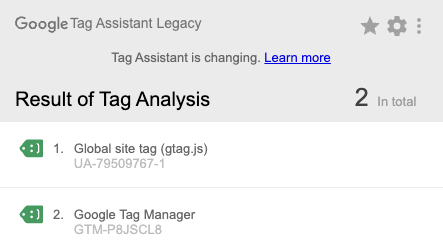 Screenshot from Google Tag Manager, November 2021.
Screenshot from Google Tag Manager, November 2021.A correctly installed Google Analytics tag will have only one happy and green GA or GTM tag on all pages you want to track.
2. Events Reflect Business Objectives
Align event tracking with your business objectives.
Advertisement
Continue Reading Below
For affiliate sites, you may want to track outbound clicks. For informational blogs, you may want to track page scrolls, internal link clicks, or file downloads. Lead gen sites will want to capture form submissions.
Consider the obvious macro-conversions and the smaller micro-conversions to capture an accurate representation of the user journey on your website.
Once you are sure that the Google Analytics tag is installed properly and event tags reflect business objectives, you can move on to the third step.
Event tags are most commonly set up using Google Tag Manager. Check that all events are accounted for in the Google Analytics Behavior report.
Here’s how to check whether events reflect business objectives:
- Open Google Analytics.
- Open the Behavior > Events Overview Report.
- Confirm that all website actions important to your business are recorded in GA.
3. View Bounce Rate By Marketing Channel
Time to use Google Analytics to learn what factors may be influencing bounce rate.
Advertisement
Continue Reading Below
Open Google Analytics. Navigate to the Acquisition > All Traffic Report by Default Channel Grouping.
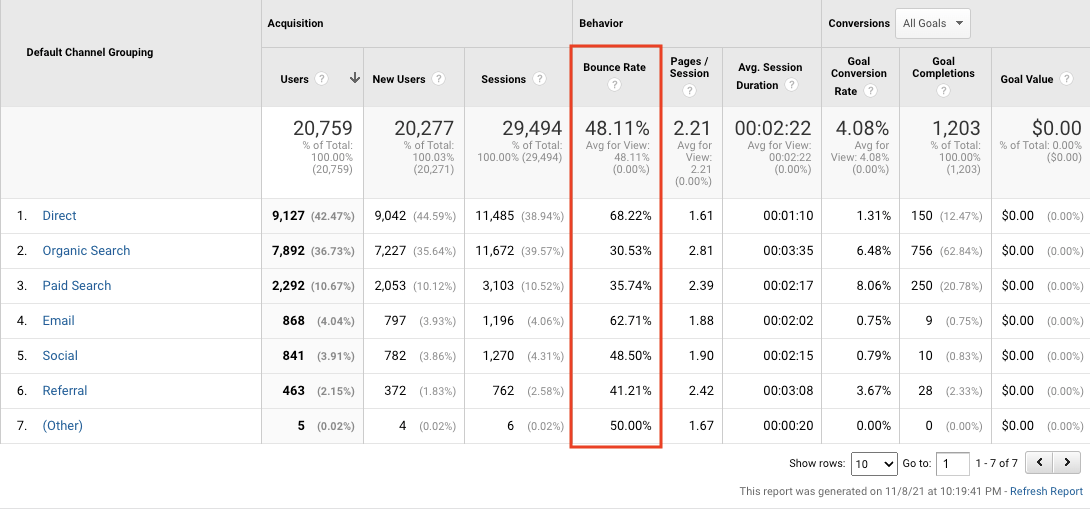 Screenshot from Google Analytics, November 2021
Screenshot from Google Analytics, November 2021From this report, you are able to view site bounce rates by marketing channel and be able to tell if this is a genuine issue or natural growth.
For example, social-media traffic includes a broad range of users who may only care about the content on a specific landing page. There is no need for the user to explore the website deeper.
Advertisement
Continue Reading Below
4. Explore High Bounce Rate
The final step in doing a bounce rate audit is to uncover the page(s) responsible for the abnormally high bounce rate.
To do this, click on the Channel Grouping of interest; for example, “Organic Search.”
Select the primary dimension as “Landing Page.”
Click on the header “Bounce Rate” to sort the table.
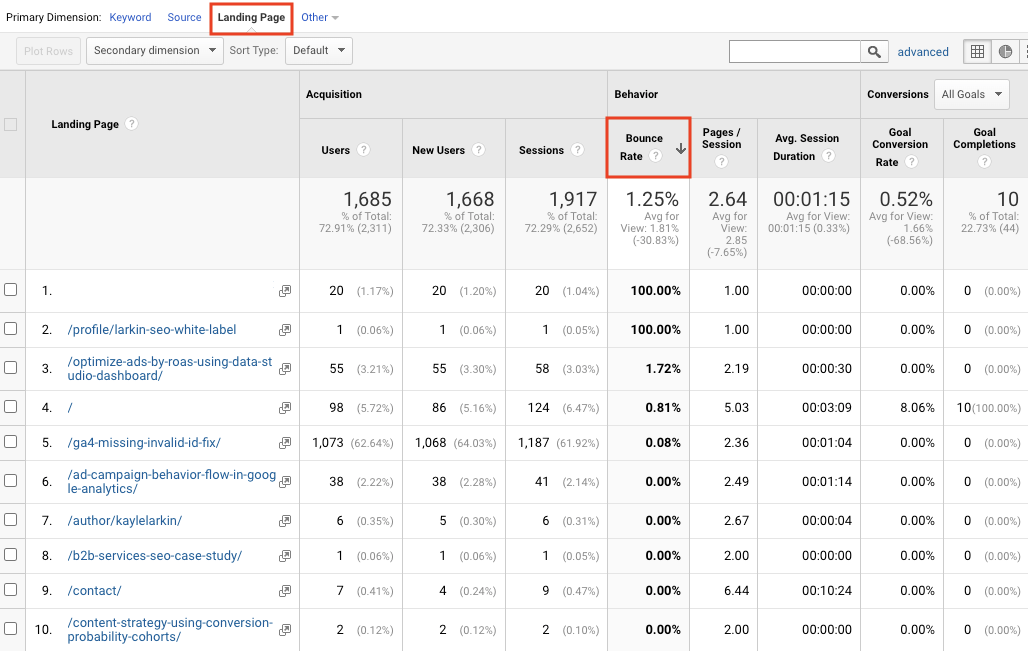 Screenshot from Google Analytics, November 2021
Screenshot from Google Analytics, November 2021From this report, you are able to view organic sessions bounce rates by landing page.
Advertisement
Continue Reading Below
Look for patterns in the type of content.
Are the pages with a high bounce rate a blog? This may still not be an issue for alarm. A good landing page that fully covers a targeted topic will give visitors every detail they were looking for.
Bounce rates for a blog can be 70 to 90%, on average.
However, if the page is for lead generation or e-commerce, you want to aim for a bounce rate between 30 and 40%.
How To Fix A High Bounce Rate
In the event you do detect a genuinely high bounce rate, this becomes a user experience issue. In that case, you may want to rewrite the introductory paragraph, improve internal linking, or increase page speed.
Rewriting the introductory paragraph may hook more readers from the get-go by really driving home the reason they need to read your article instead of competitors’.
Improving internal linking can encourage site visitors to explore related topics in greater depth, keeping them engaged with your site content longer and racking up higher page views.
Advertisement
Continue Reading Below
Increasing page speed will ensure you don’t lose potential clients to the loading wheel of doom.
Bounce Rate In GA4
If you added Google Analytics to your website after October 2020, you are likely searching within GA4 and wondering where the bounce rate went?
You won’t find bounce rate in Google Analytics 4 reports. Instead, you will be working with “engaged sessions.”
GA4 engaged sessions can be applied in situations where the traditional bounce rate could not to help marketers better understand if users are engaging with a site.
I encourage you to become more familiar with GA4 and “engaged sessions.” The new metrics solve a lot of problems.
By nature, we are resistant to change. There will inevitably be an adaptation period while you get used to the new GA4 interface and metrics.
Final Thoughts
It’s important that you remember that the bounce rate you see in reports can be affected by tag implementation, event tracking, marketing channel, and content type.
Advertisement
Continue Reading Below
To gather better insights into user engagement, set up Google Analytics in a way that reflects your business objectives.
More resources:
Featured image 1: Submitted by author
Featured image 2: Shutterstock/TarikVision
